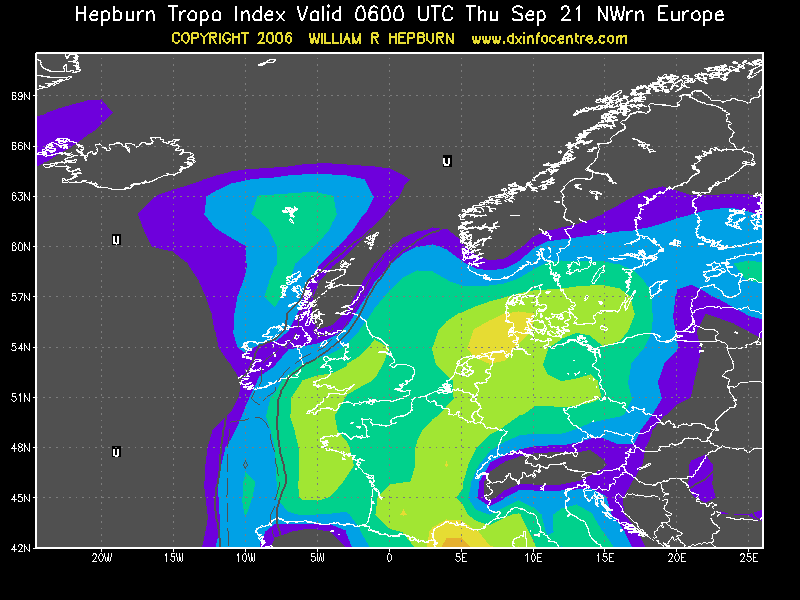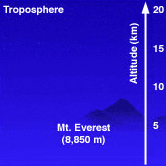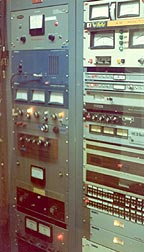Thursday 21 September, 2006, 15:40 - Amateur Radio
Most day-to-day 'DX' propagation experienced by radio users at VHF and UHF frequencies relies on some interaction between their signal and the troposphere (the troposphere is the lower layers of the atmosphere extending up to about 10 miles above sea level). For anyone wanting to find out more about the different modes of tropospheric propagation, there is an excellent article by William Hepburn that describes them all.  The same web-site also gives 5 day predictions as to the possible level of tropospheric propagation that can be expected too - very interesting.
The same web-site also gives 5 day predictions as to the possible level of tropospheric propagation that can be expected too - very interesting.Having recently installed a simple VHF antenna on my house, I thought I'd do the usual thing and tune around the various amateur repeaters to see what kind of coverage I was achieving. According to predictions that I had done, I expected to be able to just about receive transmitters from a maximum of 80 miles away (my location is nothing special). I was a bit surprised to discover that I could regularly hear stations from around 150 miles (225 km) away on 2 metres (145 MHz) and similar distance but less commonly on 70 cm (433 MHz). Indeed with the radio on in the background whilst working one day, a number of repeaters on the same channel at distances of around 150 miles faded in and out with alarming regularity.
 Of course the culprit in extending my range in this way is the troposphere (together with the fact that most amateur repeaters tend to be high up to give wide coverage to start with). It would seem that, even on an almost 'flat' day, there is enough going on in the atmosphere to enhance reception (and transmission) even for a fairly simple set-up in a fairly average location.
Of course the culprit in extending my range in this way is the troposphere (together with the fact that most amateur repeaters tend to be high up to give wide coverage to start with). It would seem that, even on an almost 'flat' day, there is enough going on in the atmosphere to enhance reception (and transmission) even for a fairly simple set-up in a fairly average location.Now from an amateur radio perspective, this is great fun. From a 'professional' radio user's perspective this must prove a nightmare. Typically VHF frequencies will be re-used witin about a 80 mile radius, so that under totally flat conditions there is theoretically no potential for interference. However if 'tropogation' is as common as it would appear to be from my location, the levels of interference between commercial VHF (and to a lesser extent UHF) users must be a real nuisance - and there's nothing that can be done about it. Or is there...?
 Some television transmitters employ a technique known as 'beam-tilt' which points the signal from a transmitter slightly below horizontal. Doing this limits the range of the transmitter whilst at the same time reducing interference further away and producing a slightly stronger signal in the wanted coverage area. A beam-tilt of about 1 degree down from the horizon can make quite a difference. The problem is that it takes careful antenna design and often quite large and complex antennas to achieve beam-tilt so it isn't a solution for your average taxi company or security company.
Some television transmitters employ a technique known as 'beam-tilt' which points the signal from a transmitter slightly below horizontal. Doing this limits the range of the transmitter whilst at the same time reducing interference further away and producing a slightly stronger signal in the wanted coverage area. A beam-tilt of about 1 degree down from the horizon can make quite a difference. The problem is that it takes careful antenna design and often quite large and complex antennas to achieve beam-tilt so it isn't a solution for your average taxi company or security company.A solution which is within the financial reach of most users is something known as CTCSS. This encodes a sub-audible (i.e. silent) tone onto each transmitter. Only transmitters and receivers set to use the same tone can hear each other. Such a system stops receivers from falsely hearing interfering transmitters - always assuming that the interfering transmitter has a different CTCSS tone to the one you want to receive. CTCSS, however, wouldn't stop the signal from causing interference, just stop you from hearing it.
Anyway, none of this is a problem for me. I'm just happy that my humble set-up is providing hours of endless fun (hmmm... must find something better to do) as I hear distant repeaters come and go!
